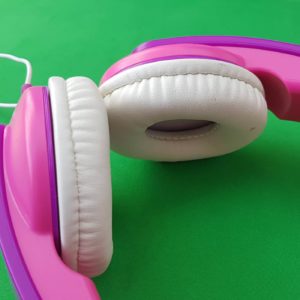
Do you listen to the Bible?
I’ve noticed that listening to the Bible is seen as a second-rate option to reading it. And much as I love reading the Bible and exploring it in detail, I would like to explore the merits and benefits of listening to it, and especially how this can add to our growing faith as families.
How it started
When the Bible was first written, it was written down after being used as an oral text. This means most of the words we now read were originally heard by people listening to someone else speak them, rather than reading the words. The culture was different, of course, and most people did not read, paper hadn’t been invented, as so recording words in a written format was specialist work, not like the word-generating technology we have today! This was true when the Old and New Testaments were written and for most of history. Think of that! Most people who have lived and heard the words of the Bible could not read it for themselves and relied on the words being read and repeated to them by others. This is why so many churches were covered in paintings of Biblical scenes, why the first plays in England are said to have been done by clergy in the church, and why the invention of the printing press changed everything.
Since then the Bible has been translated into English (and hundreds of other languages), paper has become cheaper, education has become compulsory and now most people in the world can access the Bible in a written format.
However, I propose that just because we can read it doesn’t mean this is the only or even always the best way we can access God’s word. Even that classic quote from Romans 10:17 says “Faith comes through hearing” – not reading!
Learning and spiritual styles
Modern science has recently shown us why pictures and dramas and stories told to us are so fab. We now know that people learn in different ways, called learning styles. The most basic version of this is VAK: visual, auditory, and kinaesthetic. While it’s interesting to work out people’s most prominent choice of these, I prefer to work in methods which work for all three, for example using pictures while telling a story and giving people something to do with their hands while I’m talking. When it comes to faith, it’s been well documented that we also have different spiritual styles, and so it seems pretty obvious that we shouldn’t stick to one method of teaching the Bible or promote only one way in which people can connect with God through it.
I discovered how audio Bible works well for my kinaesthetic daughter, who likes to play with lego or draw or create random creations but is listening intently to the story as she does so. It’s a classic mistake to make – to assume that because someone isn’t looking like they’re paying attention that they’re not. I love to write and draw while listening to sermons, so this really shouldn’t surprise me.
Seasons of life
For some people in some situations and seasons of life, connection and learning will come easily through reading the Bible. I found this was me until I became a parent, and overnight I became an audiobook fan, including the Bible. I found my sleep-deprived brain could still take in a little of what I listened to during long night feeds which made me feel less like it was ‘wasted’ time (although clearly feeding a baby isn’t ever wasted time!). I found tiny slots of time while washing up or putting washing away were possible to fill with a little audio which helped me connect with my adult brain which otherwise felt as if I was turning to mush.
There are surely other seasons where an audio Bible might be the only form we can connect with, such as illness or sight loss. How about when we’re just tired and need to close our eyes. There is surely no loss in the power of God’s word to speak to me just because I am not reading it!
Large chunks
I discovered as I shared audiobooks with my children in the car that we could cover huge amounts of the Bible with an audiobook in a much shorter time than we could if I were reading it. We used audio recording on the YouVersion app in the car, and I was amazed at how long a story they would not only allow me to play but actively engage with. One time we were listening to the Exodus story in Exodus 1-15 in preparation for Passover, and they asked for a long car journey so we could carry on with the story! I love how this method helps us get to grips with massive stories like Exodus or the Easter story in a way which would take us days or weeks otherwise.
Journeying together
Another thing listening to the Bible together does is put me on the same level as my children – we are both listeners, both wanting to grasp the story, both with questions, both with ideas. It levels the playing field and helps explore the Bible together to be a journey we do side-by-side, rather than positioning me as the teacher. I like this, as it also releases me from the job of reading the ‘script’, and gives me more space to ask questions, to wonder myself about the words, to pay attention to their words and body language as they explore.
Current culture and special needs
While reading is still currently the dominant form of learning in our culture, for many people it isn’t. Children under the age of about 7 learn better when not having to navigate the text. Anyone who struggles with reading for whatever reason at whatever age, they are better off with an audio Bible. And for the generation growing up with YouTube as their teacher, this may be the way they learn everything – maybe what they need is videos of people reading the Bible. A quick search provides a plethora of options: videos of Bible verses with gentle spa-type music to go to sleep with, and guided meditations, some are just a voice and others are dramatized, which personally I find easier to listen to. I found many of the readers had voices I would find really hard to listen to, but this is subjective so it’s worth listening to a few. Many don’t have pictures of the person reading, some have videos of lakes and skies instead, and others just a photograph. Do these exist? We should make some!
Listening as a route to speaking
Listening to the Bible and repeating what is read is one of the simplest ways of learning Bible verses. I’ve recently done this with Shakespeare with my six and seven-year-olds, and realised if they can learn ten Shakespeare quotes and use them with comedic effect in everyday life, how much more could they learn and use Bible verses? We’ve learnt quite a few quotes by using them in our weekly Shabbat meal so that by listening to the same verses each week, our children have learnt at least 5 sections of Scripture. This would be easy to do using an audio Bible, just putting the same verses on each day or each week. Over a period of time, just hearing means we become familiar with the words. And knowing the words, we then have the opportunity to discuss their meaning, to meditate on them and their meaning for us, and to share them with others.
Let’s do it!
There’s no time like the present, so grab your phone and open your Bible app, and choose a Bible verse or short-ish passage you’d like to listen to. It might be one which is speaking to you at the moment, one you are preparing a talk on, or one you’d like to know off by heart. Choose a Bible version with an audio option and listen to it with your eyes shut. Allow the words to help you create images and feelings and thoughts about what you’re hearing. You may enjoy doing a creative activity like lego or colouring while you’re listening. Listen to it on repeat and start joining in the words as you remember them. Listen to it four or five times, then record yourself saying it. See if you know it, correct any mistakes and listen again. Reflect on the different experiences of listening compared to reading. Share this with someone!
